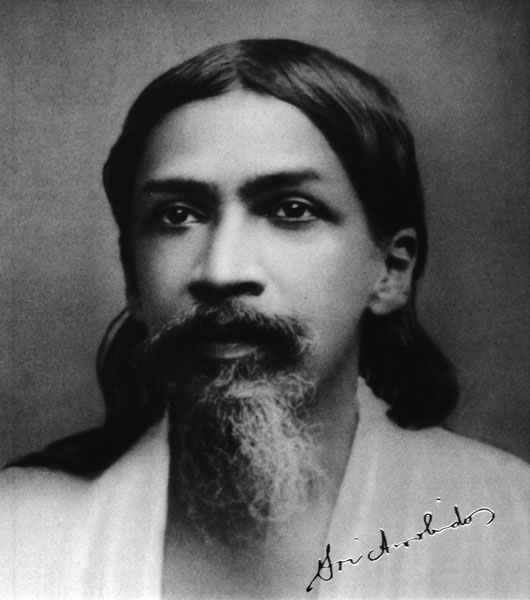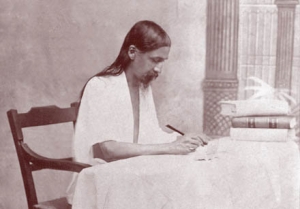Sri Aurobindo’s Teaching and Method of Sadhana
Sri Aurobindo’s Teaching and Method of Sadhana
The following is from SABCL, Vol. 26, “Sri Aurobindo on Himself”, pp. 95-97. It also appears in the recent book The Mind of Light published by Lotus Press in December 2003.
The teaching of Sri Aurobindo starts from that of the ancient sages of India that behind the appearances of the universe there is the Reality of a Being and Consciousness, a Self of all things, one and eternal. All beings are united in that One Self and Spirit but divided by a certain separativity of consciousness, an ignorance of their true Self and Reality in the mind, life and body. It is possible by a certain psychological discipline to remove this veil of separative consciousness and become aware of the true Self, the Divinity within us and all.
Sri Aurobindo’s teaching states that this One Being and Consciousness is involved here in Matter. Evolution is the method by which it liberates itself; consciousness appears in what seems to be inconscient, and once having appeared is self-impelled to grow higher and higher and at the same time to enlarge and develop towards a greater and greater perfection. Life is the first step of this release of consciousness; mind is the second; but the evolution does not finish with mind, it awaits a release into something greater, a consciousness which is spiritual and supramental. The next step of the evolution must be towards the development of Supermind and Spirit as the dominant power in the conscious being. For only then will the involved Divinity in things release itself entirely and it become possible for life to manifest perfection.
But while the former steps in evolution were taken by Nature without a conscious will in the plant and animal life, in man Nature becomes able to evolve by a conscious will in the instrument. It is not, however, by the mental will in man that this can be wholly done, for the mind goes only to a certain point and after that can only move in a circle. A conversion has to be made, a turning of the consciousness by which mind has to change into the higher principle. This method is to be found through the ancient psychological discipline and practice of Yoga. In the past, it has been attempted by a drawing away from the world and a disappearance into the height of the Self or Spirit. Sri Aurobindo teaches that a descent of the higher principle is possible which will not merely release the spiritual Self out of the world, but release it in the world, replace the mind’s ignorance or its very limited knowledge by a supramental Truth-Consciousness which will be a sufficient instrument of the inner Self and make it possible for the human being to find himself dynamically as well as inwardly and grow out of his still animal humanity into a diviner race. The psychological discipline of Yoga can be used to that end by opening all the parts of the being to a conversion or transformation through the descent and working of the higher still concealed supramental principle.
This, however, cannot be done at once or in a short time or by any rapid or miraculous transformation. Many steps have to be taken by the seeker before the supramental descent is possible. Man lives mostly in his surface mind, life and body, but there is an inner being within him with greater possibilities to which he has to awake – for it is only a very restricted influence from it that he receives now and that pushes him to a constant pursuit of a greater beauty, harmony, power and knowledge. The first process of Yoga is therefore to open the ranges of this inner being and to live from there outward, governing his outward life by an inner light and force. In doing so he discovers in himself his true soul which is not this outer mixture of mental, vital and physical elements but something of the Reality behind them, a spark from the one Divine Fire. He has to learn to live in his soul and purify and orientate by its drive towards the Truth the rest of the nature. There can follow afterwards an opening upward and descent of a higher principle of the Being. But even then it is not at once the full supramental Light and Force. For there are several ranges of consciousness between the ordinary human mind and the supramental Truth-Consciousness. These intervening ranges have to be opened up and their power brought down into the mind, life and body. Only afterwards can the full power of the Truth-Consciousness work in the nature. The process of this self-discipline or Sadhana is therefore long and difficult, but even a little of it is so much gained because it makes the ultimate release and perfection more possible.
There are many things belonging to older systems that are necessary on the way – an opening of the mind to a greater wideness and to the sense of the Self and the Infinite, an emergence into what has been called the cosmic consciousness, mastery over the desires and passions; an outward asceticism is not essential, but the conquest of desire and attachment and a control over the body and its needs, greeds and instincts are indispensable. There is a combination of the principles of the old systems, the way of knowledge through the mind’s discernment between Reality and the appearance, the heart’s way of devotion, love and surrender and the way of works turning the will away from motives of self-interest to the Truth and the service of a greater Reality than the ego. For the whole being has to be trained so that it can respond and be transformed when it is possible for that greater Light and Force to work in the nature.
In this discipline, the inspiration of the Master, and in the difficult stages his control and his presence are indispensable – for it would be impossible otherwise to go through it without much stumbling and error which would prevent all chance of success. The Master is one who has risen to a higher consciousness and being and he is often regarded as its manifestation or representative. He not only helps by his teaching and still more by his influence and example but by a power to communicate his own experience to others.
This is Sri Aurobindo’s teaching and method of practice. It is not his object to develop any one religion or to amalgamate the older religions or to found any new religion – for any of these things would lead away from his central purpose. The one aim of his Yoga is an inner self-development by which each one who follows it can in time discover the One Self in all and evolve a higher consciousness than the mental, a spiritual and supramental consciousness which will transform and divinise human nature.
Frequently Asked Questions:
What are the main lines of practice of Sri Aurobindo’s Yoga?
In Sri Aurobindo’s view, Man, at present, lives mostly in his surface mind, life and body. There is an inner being within which pushes him to a constant pursuit of a greater beauty, harmony, power and knowledge. He has to awake to the greater possibilities of this inner being and purify and orientate by its drive towards the Truth the rest of the nature.There can follow afterwards an opening upward to the several ranges of consciousness between the ordinary human mind and the Supramental Truth-Consciousness and their power brought down into the mind life and body. This will enable the full power of the Truth-Consciousness to work in the nature.
Is this not a very difficult spiritual discipline?
The opening of all parts of the being to a conversion through a descent and working of the higher Consciousness cannot be done at once or in a short time or by any rapid or miraculous transformation. Many steps have to be taken by the seeker before this is possible. The process of this discipline is therefore long and difficult but even a little of it is so much gained because it makes the ultimate release and perfection more possible.
Institute for Wholistic Education Home Page
(c) All quotations from Sri Aurobindo are copyright Sri Aurobindo Ashram, Pondicherry, India. All rights reserved.
IWE Affiliations
The Institute works with the following organizations on an ongoing basis:
Lotus Press (US publisher of Sri Aurobindo’s writings)
Sri Aurobindo Studies Daily Blog
Sri Aurobindo’s Writings Facebook Page
Internatural (online retailer natural health & wellness products)
Four Worlds Development Corp. (First Nations)
Lotus Light Enterprises (wholesale distributor natural health & wellness products)
Lotus Brands, Inc. (natural health & wellness brands)
Auroma International, Inc. (importer of Auroshikha Incense & Chandrika Soap)
Inner Worlds Music (featuring Merlin’s Magic
New Leaf Distributing Co. (wholesale distributor of metaphysical and wellness books)
American Institute of Vedic Studies
to read PDF files

Gems from Sri Aurobindo:
“A civilisation is to be judged by the power of its ideas.”
“Evolution is the one eternal dynamic law and hidden process of the earth-nature.”
“All existence is a manifestation of God.”
“Spirituality is a single word expressive of three lines of human aspiration toward divine knowledge, divine love and joy, divine strength.”
“We imagine that the soul is in the body, almost a result and derivation from the body; but it is the body that is in the soul and a result and derivation from the soul.”
“There in the silence few have ever reached, Thou shalt see the Fire burning on the base stone and the deep cavern of thy secret soul.”
“A deeper brotherhood, a yet unfound law of love is the only sure foundation possible for a perfect social evolution, no other can replace it.”
“Only by the ascent to a highest Truth and the descent of that highest Truth can Love be delivered from the cross and placed on the throne.”
“To find, know and possess the Divine existence, consciousness and nature and to live in it for the Divine is our true aim and the one perfection to which we must aspire.”
“True happiness lies in the finding and maintenance of a natural harmony of spirit, mind and body.”
“The heart of man is nearer to the Truth than his intelligence.”
“Without realisation our mental belief cannot become a dynamic reality.”
“The example is more powerful than the instruction.”
“An inch of experience goes farther than a yard of logic.”
Sri Aurobindo’s Writings:
Sri Aurobindo was a prolific writer over a wide range of subjects including philosophy, yoga, poetry, human unity and much more. Most of his major works have been published in US editions by Lotus Press.



